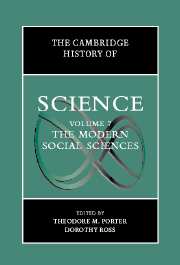Book contents
- Frontmatter
- 1 Introduction: Writing the History of Social Science
- PART I SCIENCES OF THE SOCIAL TO THE LATE NINETEENTH CENTURY
- PART II THE DISCIPLINES IN WESTERN EUROPE AND NORTH AMERICA SINCE ABOUT 1880
- PART III THE INTERNATIONALIZATION OF THE SOCIAL SCIENCES
- PART IV SOCIAL SCIENCE AS DISCOURSE AND PRACTICE IN PUBLIC AND PRIVATE LIFE
- 30 The Uses of the Social Sciences
- 31 Managing the Economy
- 32 Management and Accounting
- 33 Polling in Politics and Industry
- 34 Social Science and Social Planning During the Twentieth Century
- 35 Social Welfare
- 36 Education
- 37 The Culture of Intelligence
- 38 Psychologism and the Child
- 39 Psychiatry
- 40 Gender
- 41 Race and The Social Sciences
- 42 Cultural Relativism
- 43 Modernization
- Index
- References
33 - Polling in Politics and Industry
from PART IV - SOCIAL SCIENCE AS DISCOURSE AND PRACTICE IN PUBLIC AND PRIVATE LIFE
Published online by Cambridge University Press: 28 March 2008
- Frontmatter
- 1 Introduction: Writing the History of Social Science
- PART I SCIENCES OF THE SOCIAL TO THE LATE NINETEENTH CENTURY
- PART II THE DISCIPLINES IN WESTERN EUROPE AND NORTH AMERICA SINCE ABOUT 1880
- PART III THE INTERNATIONALIZATION OF THE SOCIAL SCIENCES
- PART IV SOCIAL SCIENCE AS DISCOURSE AND PRACTICE IN PUBLIC AND PRIVATE LIFE
- 30 The Uses of the Social Sciences
- 31 Managing the Economy
- 32 Management and Accounting
- 33 Polling in Politics and Industry
- 34 Social Science and Social Planning During the Twentieth Century
- 35 Social Welfare
- 36 Education
- 37 The Culture of Intelligence
- 38 Psychologism and the Child
- 39 Psychiatry
- 40 Gender
- 41 Race and The Social Sciences
- 42 Cultural Relativism
- 43 Modernization
- Index
- References
Summary
Survey research has a relatively short history, since the systematic practice of aggregating preferences dates back only to the nineteenth century. Scholars, statesmen, and businessmen had an interest in the nature of public opinion long before the nineteenth century, of course, but technically sophisticated attempts to quantify popular sentiment trailed far behind theorizing and discussion of it. In the twentieth century, most Western democracies witnessed a tremendous surge in survey research with the emergence of large commercial firms devoted to counting individual opinions, preferences, and attitudes. This chapter will focus on three moments in the development of survey research: the proliferation of the straw poll in mid nineteenth-century America, the vital period between 1930 and 1950 across several national settings, and contemporary debates over the uses of opinion research in a democratic state.
The meaning of the term “public opinion” itself is tied to historical circumstances, as are methods for measuring it. These days, we have all become accustomed to the constant flow of polling data in our mass media, and to their underlying assumption – that public opinion can be defined as the aggregation of individual opinions. But public opinion has not always been conceptualized or measured in an aggregative fashion. For example, Jacques Necker (1732–1804), the finance minister of France, proposed that public opinion was equivalent to the “spirit of society.” Public opinion was a wise court, embedded in communication and conversation, which made societies stable, rising up slowly and rationally when necessary in response to important events. Necker viewed the salons of the period (elite drawing-room discussions of politics, art, and religion) as manifestations and indicators of public opinion – a far cry from the polls and surveys of today.
- Type
- Chapter
- Information
- The Cambridge History of Science , pp. 577 - 590Publisher: Cambridge University PressPrint publication year: 2003
References
- 4
- Cited by



